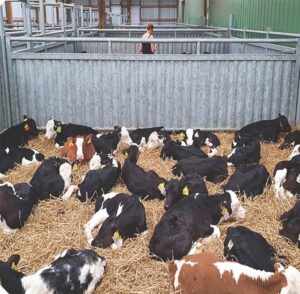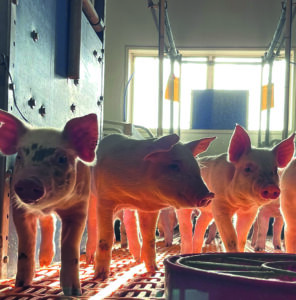Animal health & welfare
Welfare of long-distance transportation of unweaned calves

Muireann Conneely, Luca van Dijk, Susanne Siegmann, Niamh Field, Katie Sugrue, Laurence Shalloo, Emer Kennedy
Improving the welfare of unweaned calves undergoing long-distance transportation from Ireland to mainland Europe is essential. This is based on both the requirement for the highest standards of calf welfare, and growing public concerns.
This project examined the welfare of unweaned calves during long-distance transport from Ireland to the Netherlands and explored strategies to improve it. It assessed welfare using physiological indicators such as energy balance, hydration status, body weight changes, and clinical signs of illness. Respiratory disease was evaluated using thoracic ultrasound, and behaviour during transport was monitored using pedometers and visual observation.
To improve calf energy balance, different feeding strategies were evaluated, including increasing milk volume fed before transport. Also trialled was a state-of-the-art feeding system that delivered milk replacer to calves while on the ferry, aiming to support their nutritional needs in transit.
This research has demonstrated to the European Commission that Ireland is actively addressing calf welfare during transport. Accurately measuring the welfare impacts associated with transporting unweaned calves is essential to improving overall welfare standards. The inter-community trade of calves plays a key role in Ireland’s ability to meet its climate targets, and our research supports this by ensuring that high welfare standards are upheld. Notably, the research has shifted the conversation – from calls to limit the transport of unweaned calves to the development of practical strategies for feeding calves during transit. As a result, the work has had a meaningful impact on European policy discussions.
Contact: muireann.conneely@teagasc.ie
Other contributors: Wageningen University and Research; Munster Technological University; VanDrie Group
Funding: Teagasc Walsh Scholars Programme; Teagasc core funding
Impact Pathway: Policy Influencing
New technologies to reduce antibiotic use on pig farms

Juan Manuel Ortiz Sanjuán, Fiona Crispie, Paul Cotter, Edgar Garcia Manzanilla
Piglet diarrhoea at weaning is the main reason for the use of antibiotics on pig farms worldwide. In the EU, the use of preventive antibiotic and therapeutic zinc oxide in piglet diets was banned in 2022. Understanding piglet diarrhoea in this new context is key to finding solutions.
The latest bacterial sequencing technologies were used in a series of field trials on commercial pig farms to show farmers and farm staff how bacteria changed in their farms when not using antibiotics and zinc oxide. The main pathogens, including E. coli, were clearly identified, the timeline of the changes was described, and solutions were suggested for each farm to prevent piglet diarrhoea. The solutions included strategies like piglet management, hygiene or biosecurity changes.
Antimicrobial use on Irish pig farms dropped by 35% between 2022 and 2024.
The focus of the solutions for diarrhoea in piglets when antibiotics and zinc oxide were available was mainly treating the piglet at weaning. This research shows the pathogens that needed to be targeted and that the focus should be in earlier piglet stages. These studies were carried out in eight commercial Irish pig farms (8% of the Irish sow population). All the farms have made significant progress towards total removal of antibiotics and the results are a good example for other farms to follow. Between 2022 and 2024 antimicrobial use on Irish pig farms has dropped by 35% and this reduction has been maintained despite the ban of preventive antibiotics and zinc oxide.
Contact: edgar.manzanilla@teagasc.ie
Other contributors: INRAE (French National Institute for Agriculture, Food and Environment); University College Dublin
Funding: Teagasc Walsh Scholars Programme; Department of Agriculture, Food and the Marine
Impact Pathway: Technology Development & Adoption
